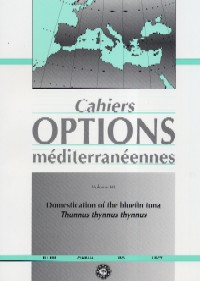| Article précédent | p. 113-114 | Article suivant |
Seasonal changes of quantitative and qualitative performances of 72 tall fescue populations in Algeria
The main feeding sources for livestock in Algeria are vegetation of grazed fallow lands, steppe rangelands and harvest residues. The proportion of green forages in the ration is very poor, not to say absent most of the year. Therefore, green forage production offers great possibilities. With this aim in mind we have conducted the present study on local and introduced populations of tall fescue. Traits related to green and dry matter yield, dry matter content and development have been examined. The results obtained show the superiority of local and Tunisian populations and that there are 4 high-performing varieties out of a total of 20. This work shows the importance of autochthonous varieties, which can be used to enrich forage systems by introducing temporary meadows made up of a mix of one or two species or by single species.
- [ Afficher ]
- [ Télécharger ]
- [ Exporter la citation ]
Vous pouvez télécharger la citation au format :
- [ Imprimer ]
-
Mots-clés
FESTUCA, GRAMINEE FOURRAGERE, RENDEMENT, RESSOURCE GENETIQUE, VALEUR NUTRITIVECiter cet article
Mohguen Khalissa K., Abdelguerfi A. Seasonal changes of quantitative and qualitative performances of 72 tall fescue populations in Algeria. In : Ferchichi A. (comp.), Ferchichi A. (collab.). Réhabilitation des pâturages et des parcours en milieux méditerranéens . Zaragoza : CIHEAM, 2004. p. 113-114. (Cahiers Options Méditerranéennes; n. 62). 11. Réunion du Sous-Réseau Ressources Fourragères Méditerranéennes du Réseau Coopératif Interrégional FAO-CIHEAM de Recherche et Développement sur les Pâturages et les Cultures Fourragères, 2002/10/29-2002/11/01, Djerba (Tunisia). http://om.ciheam.org/om/pdf/c62/04600141.pdf



